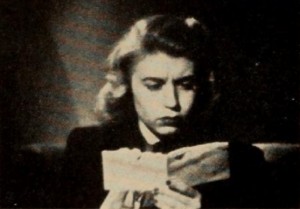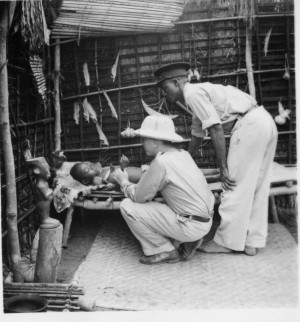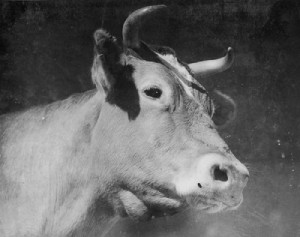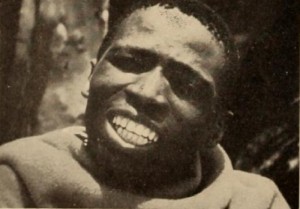
"Although there is no actual violence portrayed in this psychological thriller, Storm Due — in which a young wife discovers her husband to be a murderer — is instinct with mounting tension and terror. Francis J. Barrett's film is a potent combination of several related elements. Wedded almost as one are dramatic, hard-hitting camera angles and the visual stimulus of brilliant, low-key lighting. Acting of theatrical calibre by the young wife is accented by an off-stage voice which underlines her fears — a technique that suggests a loan from the best in modern radio. A taut continuity only hints at the story line as it hurries through this exciting evocation of violence. This very economy of dramatic exposition, in fact, will make Storm Due an unpopular and often misunderstood production. For these reviewers, however, it remains creative cinema of a very high order." Movie Makers, Dec. 1949, 454-455.
"The film opens with an introduction to some of the animals and insects that may be found in the remote countryside, all enjoying themselves in the warm sun. Suddenly a storm gathers and the wild life begin to show anxiety a sort of expectancy as the trees respond to the winds. The fury of the story is upon us - lighting, thunder, wind, rain. The elements are present in full force. Soon it is spent and quietude is again part of the country. A simple episode of nature, but told with action, feeling, and sound, coordinated into a wonderful storm. This is will be included in the Package" PSA Journal, Oct. 1962, 33.
"The story concerns an incident involving a psychopathic criminal at large. It is told by a radio narrator during his nightly program and through flashbacks of the action itself. All action takes place at night, which placed an added burden on the abilities of Cowart. Nevertheless, his lighting of the night shots, both indoors and out are as good as one sees in theatre films today. The closeups of the radio narrator could be cut a little tighter, thus speeding up the pace, but that is about the only serious criticism one can find with this unusual amateur production." American Cinematographer, May. 1952, 222.
"Depicts in detail the making of a silver coffee pot by silversmith George Bennett of W.A. Carmichael's shop in Victoria. Won honourable mention in the amateur category at the 1952 Canadian Film Awards" (Duffy, 182).

"The Story of Bamba is a drama filmed in Africa by Ray L. Garner for the Harmon Foundation in New York. This reviewer calls the production a film drama advisedly, for, although it is made as a report of the medical work of a missionary group in Africa, the picture is, in itself, an entertaining photoplay. The boy, Bamba, is the nephew of the tribal witch doctor who cures sickness with his fetishes. Bamba is to become the medicine man's successor, but he falls ill with the fever and is deserted by the tribe when they hurriedly flee their village to rid themselves of a plague. Rescued and cured by the native representative of the missionary medical center, Bamba is sent to school so that he too, can cure in the white man's way. An adult, he returns to his own tribe, where he meets and finally overcomes the resistance of his uncle. Thus, the plot unfolds clearly and entertainingly, yet the story does not interfere with a complete exposition of the medical work of missionaries. Skillful handling of native actors is apparent in every scene, for there is scarcely an unconvincing piece of business in the whole film. Camera treatment is matter of fact but adequate." Movie Makers, Dec. 1939, 637.
Produced by Nippon Television Network Corporation, New York, New York.

"In this feature length publicity picture, Mr. Judson has portrayed, with unfailing technical excellence and a genuine feeling for smooth cinematic design, the birth and growth to maturity of the famous Adohr Guernsey, Linetta, judged grand champion of her breed at the California State Fairs of 1935 and 1936. Save for the fact that practically all the scenes take place on Adohr farms and ranches, the film is devoid of advertising as it tells a simple and satisfying story, replete with human interest." Movie Makers, Jan. 1937, 24.

"Through the eyes and experiences of Matsela, a statuesque native of Basutoland, South Africa, Lewis Lewis reveals a stirring story of the triumph of modern agricultural science over the warring elements of nature. The account of how Matsela and his people all but perish in the dust bowl created by malevolent storms and drought, how he studies under a government program of soil reclamation and triumphantly puts his new training to work, provides an absorbing drama and an enlightening document on one of the world's grave problems. Although dealing with literal facts, Mr. Lewis dramatizes the incidents in his story with telling skill. Superb camera work and an attractive variety of viewpoints aid the dramatic effect, while a fascinating score of native songs further enhances the presentation. Save as a scientific record, the film is somewhat overlong, with the second of three 900 foot reels regrettably slow paced after the swift excitement of the opening chapter." Movie Makers, Dec. 1949, 455.
"An outstanding example of what may be done with ordinary 16mm. equipment in the factory is to be found in The Story of Maytag, a black and white industrial film made by Fred Maytag, II. The problems of picturing the manufacture of washing machines in complete detail involved some tremendous lighting difficulties. Mr. Maytag handled these with ease, and throughout the film there is the conviction that the clear, clean photography scarcely could be improved. While the film was designed for use within the sales organization, the procedure of manufacture is so clearly pictured that it is not only comprehensible to the layman but interesting as well." Movie Makers, Dec. 1936, 548-549.
A nature documentary on Bees.
Total Pages: 299